|
Page < 1 2 3 4 5 6 7 8 9 10 11 >
Islamic Hoards and
Their Terror - By B. R. Ambedkar
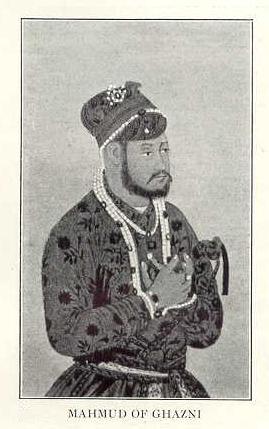 The first Muslim invasion of India came from the north-west
by the Arabs who were led by Mahommad Bin Qasim.
It took place in 711 A.D. and resulted in the conquest of Sind. This first
Muslim invasion did not result in a permanent occupation of the country because
the Caliphate of Baghdad, by whose order and command the invasion had taken
place, was obliged by the middle of 9th century A.D. to withdraw its
direct control from this distant province of Sind. Soon after this withdrawal,
there began a series of terrible invasions by Muhammad
of Ghazni (the idol breaker)
in 1001 A.D. Muhammad died in 1030 A.D., but within the
short span of 30 years, he invaded India 17 times. He was followed by Mahommed
Ghori, who began his career as an invader in 1173. He was killed in
1206. For thirty years Muhammad of Ghazni ravaged India and for thirty years
Mahommad Ghori harried the same country in the same way. The first Muslim invasion of India came from the north-west
by the Arabs who were led by Mahommad Bin Qasim.
It took place in 711 A.D. and resulted in the conquest of Sind. This first
Muslim invasion did not result in a permanent occupation of the country because
the Caliphate of Baghdad, by whose order and command the invasion had taken
place, was obliged by the middle of 9th century A.D. to withdraw its
direct control from this distant province of Sind. Soon after this withdrawal,
there began a series of terrible invasions by Muhammad
of Ghazni (the idol breaker)
in 1001 A.D. Muhammad died in 1030 A.D., but within the
short span of 30 years, he invaded India 17 times. He was followed by Mahommed
Ghori, who began his career as an invader in 1173. He was killed in
1206. For thirty years Muhammad of Ghazni ravaged India and for thirty years
Mahommad Ghori harried the same country in the same way.
Then followed the incursions of the Moghul
hordes of Chenghiz Khan. They first came in 1221. They then stayed on
the border of India but did not enter it. Twenty years later, they marched on
Lahore and sacked it. Of their inroads, the most terrible was under Timur in
1398. Then comes on the scene a new invader in the person of Babar
who invaded India in 1526. The invasion of India did not stop with that of Babar.
There occurred two more invasions. In 1738 Nadir
Shah’s invading host swept over the Punjab like a flooded river
“furious as the ocean”. He was followed by Ahmad
Shah Abdali who invaded India in 1761, smashed the forces of the Marathas
at Panipat and crushed for ever the attempt of the Hindus to gain the ground
which they had lost to their Muslim invaders.
These Muslim invasions were not
undertaken merely out of lust for loot or conquest, but also to strike a blow at
the idolatry and polytheism of Hindus and establishing Islam in India.
Muhammad of Ghazni also looked upon his numerous invasions of
India as the waging of a holy war. Al’Utbi, the historian of Muhammad,
describing his raids writes:
“He demolished idol temples and established Islam. He
captured ……cities, destroyed the idolaters, and gratifying Muslims. He then
returned home and promulgated accounts of the victories obtained for
Islam……..and vowed that every year he would undertake a holy war against
Hind.”
(source: Dr. Babasaheb Ambedkar
Writings and Speeches. Reprint
of Pakistan or The Partition of India. Education Department. Government of
Maharashtra 1990 Vol. 8. p. 53-66).for more
....
The temple of Somnath, which is not very far from Dwaraka, is dedicated to Lord
Siva as Nagnath or Nageshwar Mahadev, and enshrines one of the twelve
‘Jyotirlingas’ which according to the Puranas manifested themselves as
columns of light in different parts of the country. The magnificent temple that
stands there now is a replica of the original temple. The 13th century Arab
source refers to the glories of the temple thus: "Somnath - a
celebrated city of India situated on the shore of the sea is washed by its
waves. Among the wonders of that place was the temple
in which was placed the idol called Somnat. This idol was in the middle of the
temple, without anything to support it from below or to suspend it from above.
It was held in the highest honour among the Hindus, and whoever beheld it
floating in the air was struck with amazement..."
Sultan Alau’d-Din Khalji (1296-1316), in Tarikh-I-Firuz
Shahi, op. cit:
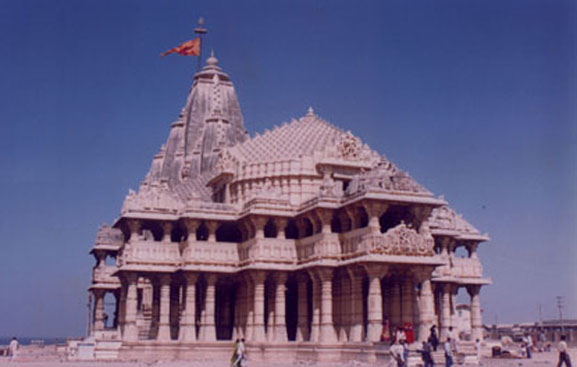 Somnath (Gujarat): “At the beginning of the third year of
the reign, Ulugh Khan and Nusrat Khan, with their amirs and generals, and a
large army marched against Gujarat…All Gujarat became prey to the invaders,
and the idol, which after the victory of Sultan Mahmud and his destruction of
)the idol) of Manat, the Brahmans had set up under the name of Somanat,
for the worship of the Hindus, was carried to Delhi where it was laid for the
people to tread upon….” (Report to the same effect in Tabqat-I-Tawarikh; the
latter also mentions that at the site of the temple a mosque was constructed.) Somnath (Gujarat): “At the beginning of the third year of
the reign, Ulugh Khan and Nusrat Khan, with their amirs and generals, and a
large army marched against Gujarat…All Gujarat became prey to the invaders,
and the idol, which after the victory of Sultan Mahmud and his destruction of
)the idol) of Manat, the Brahmans had set up under the name of Somanat,
for the worship of the Hindus, was carried to Delhi where it was laid for the
people to tread upon….” (Report to the same effect in Tabqat-I-Tawarikh; the
latter also mentions that at the site of the temple a mosque was constructed.)
(source:
Eminent
Historians: Their Technology, Their Line, Their Fraud - By Arun Shourie Harper
Collins India ISBN 8172233558 p.
107-136).
Refer to Romila
Thapar’s Kluge Prize – By Dr. Gautam Sen - vigilonline.com
"In
1193, when the Muslim conquerors reached
Bihar and massacred the 'idolatrous unbelievers', the Buddhists
were still in the majority on the lower Ganges.
According to an 11th century inscription, the great temple of Bodh
Gaya had been restored by the Burmese - an indication that the
native population had lost all interest.
(source: India
- By Martin Hurlimann p. 224). Refer
to Heroic
Hindu Resistance to Muslim Invaders (636 AD to 1206 AD) - By
Sita Ram Goel. Voice of India, New Delhi.
Sultan Mahmood Ghaznavi, who rampaged across most
of northern India converting Hindus to Islam and smashing Hindu statues. He
is said to have taken Hindu statues and put them at the entrance to a mosque in
Ghazni so the Muslim faithful could use them as stepping stones.
(source: Associated
Press).
 Dr
Rajendra Prasad (1884-1963) first President of
India, during the
renovation of the historic Somnath temple
in 1950 which was vandalised by a 11th century Muslim invader,
Mohammad Ghazni. Dr
Rajendra Prasad (1884-1963) first President of
India, during the
renovation of the historic Somnath temple
in 1950 which was vandalised by a 11th century Muslim invader,
Mohammad Ghazni.
'By
rising from its ashes again, this temple of Somnath will proclaim
to the world that no man and no power in the world can destroy
that for which people have boundless faith and love in their
hearts... Today, our attempt is not to rectify history. Our only
aim is to proclaim anew our attachment to the faith, convictions
and to the values on which our religion has rested since
immemorial ages.'
(source: Symbol
of an awakened civilization - Ram Madhav - rediff.com).
For more on Somnath refer Somnath
and Ayodhya: What Is the Difference - By David Frawley).
Refer
to Islam
Under Scrutiny by Ex-Muslims - By Alamgir Hussain -
islam-watch.org and
Jamia Millia Islamia holds conference with Vice President of
India & Fake Shankaracharya
When Marxist Historian, Romila
Thapar tries to make gullible readers believe that Mahmud Ghaznavi
only desecrated temples for their wealth she must know (assuming, as all her
quoters do, that she is competent historian) that Mahmud
is revered by the Muslims as a devout Muslim, that he calligraphed
Quran text "for the benefit of his soul", and that he
actually refused a huge ransom which Hindus were ready to pay if he agreed to
give back an idol, instead of breaking it. Mahmud
preferred breaking idols to selling them, even if that meant
foregoing wealth. So her theory of Mahmud's economical rather than religious
motives is at best an unscientific imposition of Marxist dogma upon the facts of
Indian history, otherwise a deliberate lie.
The myth of Brahmin oppression, the myth of Buddhism as a social reform
movement, the myth of the Buddhist-Brahmin power struggle, the myth of the
economical motives for the Muslim conquests and destruction, the myth of the
non-existence of an indigenous and nation-wide Hindu culture, the myth of the
social reforms brought by Islam, the myth of Hindu-Muslim amity, the myth of
Nehru and of India as a a nation in the making, the myth of the
Composite Culture, the myth that communalism is a British creation,
all these myths are bound to give way once a substantial number of Hindu
intellectuals apply their minds to them in a serious and scientific way, and
then use the available channels to speak out.
(source: Ayodhya
and After - By Koenraad Elst). Refer
to Heroic
Hindu Resistance to Muslim Invaders (636 AD to 1206 AD) - By Sita Ram Goel.
Voice of India, New Delhi.
Refer
to video Statistics
on Islamic Terrorism
- By B Raman.
Refer to Ignore
this genocide, we're secular - By Rajeev Srinivasan - rediff.com).
Also refer to Blasts
in Varanasi
"Why are there absolutely no Buddhist
temples left in Afghanistan, in Turkestan? Nor Hindu or Zorastrian or Manichaen
temples, for that matter? Secularist scholars do not seem to know that the
Buddhist monasteries and universities were destroyed and exterminated to the
last, in India just as well as in Central Asia, by none other than the Muslim
armies. So, the answer is that, while, Buddhism had been partly reabsorbed into
Hinduism, and had partly continued as a separate tradition under Hindu
dynasties, the Muslim conquerors finished it off totally."
(source: Ayodhya
and After - By Koenraad Elst Voice of India SKU: INBK2650 p. 103).
 The Quwwat ul-Islam or 'Might of Islam' Mosque,
erected on the site of Delhi's largest Hindu temple,
and it contains on three sides, by rows of stone columns pillaged from some 27
local Hindu and Jain shrines. To the southeast was erected the great Qutb (pole
or axis) Minar. It was haughtily erected as a tower of
victory, and its inscriptions proclaim its purpose - to cast a long shadow of
God over the conquered city of the Hindus. Qutub-ud-din employed the
local Hindu craftsmen of Delhi, and their beautifully detailed stonework is
everywhere in evidence. The pointed arches of the mosque's western screen were
constructed using only traditional Hindu corbelling
techniques; and around these arches and on the decorative band encircling the
minar the craftsmen carved inscriptions, in elegant Naskhi script, interspersed
with floral designs of Indian origin. The Quwwat ul-Islam or 'Might of Islam' Mosque,
erected on the site of Delhi's largest Hindu temple,
and it contains on three sides, by rows of stone columns pillaged from some 27
local Hindu and Jain shrines. To the southeast was erected the great Qutb (pole
or axis) Minar. It was haughtily erected as a tower of
victory, and its inscriptions proclaim its purpose - to cast a long shadow of
God over the conquered city of the Hindus. Qutub-ud-din employed the
local Hindu craftsmen of Delhi, and their beautifully detailed stonework is
everywhere in evidence. The pointed arches of the mosque's western screen were
constructed using only traditional Hindu corbelling
techniques; and around these arches and on the decorative band encircling the
minar the craftsmen carved inscriptions, in elegant Naskhi script, interspersed
with floral designs of Indian origin.
(source: Indian
Art - By Roy C. Craven p. 195-196). Also
refer to India:
Putting the Fallouts of the Islamic Invasion and British Occupation in
Perspective - by
Alamgir Hussain - islam-watch.org.
Refer to Heroic
Hindu Resistance to Muslim Invaders (636 AD to 1206 AD) - By Sita Ram Goel.
Voice of India, New Delhi.
Top of Page
Golden pages of
Indian History not in our textbooks?
Battle
of Baharaich
It
is interesting that none of the history textbooks we read, mention
this great victory of Indian Union over Islamic hordes from
northwest of
India
. There is a famous battle of Baharaich near
Lucknow
.
This battle was fought on 14th June 1033.
Introduction
The nephew of Mahmood Gazni, known as Masud Gazni, invaded
India
with army of more than 100,000 men in may 1031 AD. This time, the
army was not a raiding party like that of Mahmood who came with
intention of raiding, looting and retreating with the loot to
Afghanistan
. They were backed by the imperial army
Persian empire
and came here with the intention of permanent conquest and
Islamization of India.
King Anandpal Shahi tried to
check this Gazni advance towards heartland of
India
. He was helped by King of
Sialkot
, Rai Arjun. But, this alliance was overwhelmed by
superiority of numbers of Pathan army. After defeating Anandpal
Shahi and Rai Arjun, Masood advanced towards towards Malwa and
Gujarat
. King Mahipal Tomara tried to
check their advance here but was defeated too.
After victories across North Indian plains, Masood Gazni settled
at Bahraich near
Lucknow
. He stayed here up to mid 1033. Meanwhile, 17
Rajput Kings of north
India
forged an alliance. This is biggest confederation that
have ever existed in
India
. The head of this confederation was Raja
Sukhdev, a Gurjara-Rajput King. It would be interesting
to know how the alliance was forged and how was the game of chess
played before the final showdown on 14th June. However,
I have not come across any books which deals with this part of
History in detail.
In June 1033, as per Hindu traditions, Masood Gazni was intimated
by Rajput confederation that the land belonged to Rajputs and
Hindus and Masood should evacuate these lands. Masood replied that
all land belongs to Khuda and hence he would not retreat.
On 13th June, Morning, Rajput army of about 120,000 descended on
Gazni camp of Bahraich. Masood's army was completely besieged and
encircled. The battle continued for hours. In the end, each and
every man in Masood's camp was killed. No POW's were taken, no
mercy was shown on the Afghan army. The location of this battle to
be precise was near Chittaura Jheel, a lake about 8 KM away from
modern Bahraich on
Bahraich-Gond Road
. The battle ended on 14th June with Victory of Raja Sukhdev and
his Rajput alliance.
The invasion was completely crushed and such resounding was this
victory that none of the king from Northwest dared to invade
India
for 160 years..
This is one of the golden pages of Indian
History.
India
is indebted to series of Rajput Kings along the western border of
India
and in
Central India
. They were extremely instrumental in keeping Arab invaders at bay
for 3 centuries. This was the time when Arabs were at their
zenith. The Khilafat extended from Western Sindh to
Spain
.. However, they could not defeat Rajputs and enter Indian
heartlands.
Rajputs were also instrumental in initial
defeat of Muslim invaders from Northwest. The Battle of Bahraich
was the peak point of Rajput valor. Their resistance waned with
time over next 5 centuries. Rana
Pratap was perhaps last famous Rajput
general to fight invaders.
The tomb of Masood Gazni is still present at Bahraich. People
there have elevated him to the status of peer and Gaazi and
worship him. And there is no single mention of this glorious
victory of Hindus. This, in my opinion, is an insult of
Rajput valor. Same is the case with tomb of Afzal
Khan at Pratapgarh in
Maharashtra
who was slain by Shivaji.
I do not oppose theistic beliefs. However, people worshiping the
tombs of people like Masood Gazni and Afzal Khan should be made
aware of their heinous deeds.
(source:
Battle
of Baharaich
- kalchiron.blogspot.com).
It is astonishing that
we Hindus should have forgotten this memorable battle for 950 years!
Mahmood of Gazani attacked Sorti Somnath, the
famous Shiva temple in Gujrat, for the last time, in 1026. Mahmood
Ghori attacked
North India
in 1192. What happened in the intermediate period of 166 years?
Were the Muslims just too tired of raids? The answer is NO - They
did attack, but faced a fierce battle at Baharaich, 60 miles North
East of Lucknow. The entire Muslim army
was wiped out, on 14 June 1033. Not one Muslim
survived to tell people back in
Iran
this bitter news. And as a result they did not dare attack
India
for more than six generations. The details are given in "Meerat-e-Masudi"
by Sheikh Abdul Rahman Chisti. He says - Mahmood of Gazni's sister
Maula was married to Salar Sahu, the Sultan of Iran. Their son
Masood aged 12 accompanied Mahmood of Gazni on his last attack on
Somnath. In 1031 Masood with 50,000 horses accompanied by two
generals Meer Hussain Arab and Ameer Vazid Jafar attacked
India
. He crossed Sind, defeated Rai Arjun of Sahoor and King Anangpal
of
Multan
. He marched on to
Delhi
. Here he was joined by his uncle Salar Saifuddin, Meer Wakhtiar,
Meer Sayyad Ajijuddin and Malik Bahruddin and their armies. They
defeated Rai Mahipal after a battle of 5 days. Rajputs fought to
the last man. They marched on to
Meerut
and
Ujjain
whose Hindu kings made friendship treaties. Later Saket was taken.
- Miyya Rajab and Salar Saifuddin took Baharaich.
Ameer Hasan Arab took Mahoona, Malik Fazal took Banares.
Sulutanu-s-Salateen and Mir Bakhatiar went south to Kannor and
there Mir Bakhtiar was killed during a fight with the Hindus.
- Masood's father (King of
Iran
) Salar Sahu arrived at Saket with a large army. Kada and Manikpur
states were taken. Hindus fought to the
last man.
On 14 June 1033 the entire Muslim army was wiped
out at Bahraich during a pitch battle with a combined army of 17
Hindu Kings. They were Rai Raib, Rai Saib, Rai Arjun, Rai Bheekhan,
Rai Kanak, Rai Kalyan, Rai Makaru, Rai Savaru, Rai aran, Rai
Birbal, Rai Jaypal, Rai Shreepal, Rai Harpal, Rai Hakru, Rai
Prabhu, Rai Deo Narayan and Rai Narsinha. They had 20 lakh (2
Million) horsemen and 30 lakh (3 million) footmen. Rai Sahar Deo and Rai Hardev
also joined (Note - The figures of 2 million horsemen and 3
million footmen seem to be exaggerated). After the defeat of Salar
Masood, Muzzafarkhan also died at
Ajmer
. His successors were driven out by the
Hindus. All the temples were rehabitated. Bells rang without
hindrance. This state of affairs continued for 200 years.
Ref. - Tawarikh-e-Mahamood (of Mahmood of Gazani)
Tawarikh-e-Firozshahi
Muntkhabut – Tawarikh etc.
It is astonishing that
we Hindus should have forgotten this memorable battle for 950
years!
(Original paper in Hindi by Vinod Kumar Mishra of
Prayag).
(source:
INDIAN
INSTITUTE FOR RESEARCH INTO TRUE HISTORY -
Newsletter No. 13 of 16 June 1984).
Fierce and
persistent Hindu resistance to the Islamic Jihad prevented the complete
Islamization of India
Unlike
the complete Islamization of Persia,
Egypt
,
Mesopotamia
,
Turkey
,
North Africa
, the Islamization of India was never complete. After more than one millennium
of Muslim Tyranny from 715 up to 1761, more than 70 percent of the population of
India
remained Hindu.
Unlike the
Zoroastrian Persians, the Hindus never surrendered to the Muslim tyrants. They
waged a relentless and violent struggle against the Muslims. It
was the valiant Hindu resistance that put paid all the savagery of the Muslims
to convert all the Hindus to Islam at the pain of death.
***
Indian Code of
Chivalry:The Rajput and Maratha Warriors
Hindus,
like the Jews, have been subject to Muslim persecution for centuries. Following
the example set by the Prophet, Muslim invaders destroyed Hindu places of
worship and sold Hindu women and children in the slave markets of Damascus and
Baghdad. For centuries, Rajputs, Marathas, Jats and Sikhs fought Muslim
invaders.
Rajput
Kingdoms contended with the rising and expansionist empires of Central Asia, be
they Arabs, Moghuls,Mongols Afghans, or other Turks. They earned their
reputation by fighting these battles with a code of chivalrous conduct rooted in
their strong adherence to tradition and (Hindu
Dharma). The Rajput Kingdoms held
out against the Arab Caliphates and other Central Asian Empires for several
centuries. The heroism and sacrifice displayed by the Rajputs is legendary
in the chronicles of Indian history.
A point to note here is that
lot of Muslims,
Western and some Hindu
historians think that Islam/Muslims
did not do conversion of Hindus
by sword. The argument they give is that there are so many Hindus
still today in India.
This is completely wrong because most Muslim
rulers in India
tried to convert as many as they could but it was the strength of Rajput sword
and later Maratha,
Sikh swords that kept Hinduism
alive in India.
If there were no Rajputs, Marathas
, Sikhs
in India,
then India
would be just like Iraq,
Iran,
Turkey,
or Pakistan
in terms of religion of the population.
The perseverance of Hinduism
in India by the Rajput sword against the entire might of Islamic
rulers is the most glorious achievement by a race in the annals of world
history and every one should know this fact, more so Indians
and most definitely each and every Rajput. Presence of Rajput generals in Mughal
army was a blessing in disguise for the Hindu population as the mughal army when
headed by a rajput general could not engage in wanton destruction of Hindu
temples as well as mass conversion of Hindus to Islam.
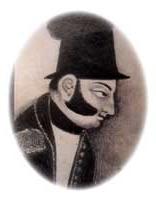 Colonel
James Todd
in his Annals and Antiquities of Rajasthan
wrote: Colonel
James Todd
in his Annals and Antiquities of Rajasthan
wrote:
"What
nation on earth could have maintained the semblance of civilization, the spirit
or the customs of their forefathers, during so many centuries of overwhelming
depression, but one of such singular character as the Rajpoot? . . .
Rajasthan exhibits the sole example in the history of mankind, of a people
withstanding every outrage barbarity could inflict, or human nature sustain,
from a foe whose religion commands annihilation; and bent to the earth, yet
rising buoyant from the pressure, and making calamity a whetstone to courage. .
. . Not an iota of their religion or customs have they
lost. . . ".
Contrast this to how Muslims
converted entire Iranian kingdom, where a very ancient religion of Zoroaster
flourished, on the edge of the sword in a very short amount of time.
(source:
The
Great Rajputs - hindurajputblogspot.com). Refer
to Heroic
Hindu Resistance to Muslim Invaders (636 AD to 1206 AD) - By Sita Ram Goel.
Voice of India, New Delhi.
For
more refer to Rajputs
and Invasion of India. Also refer to Hindu
Resistance to Islamic Jihad
Heroism of
Prithiviraj Chauhan
Prithviraj Chauhan III was the last
of the great Chauhan rulers of Ajmer who left a deep imprint in the sands of
time and redefined the concept of valour in its noblest form. The legendary
Prithviraj lived here and became a force to reckon with. His exploits are
related with great wonder and sometimes disbelief. Few rulers of that time could
match the charisma and heroism of this dynamic ruler.
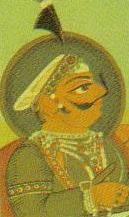 Prithviraj
was the son of Someshwara who died in 1179
A.D. The second Turkish attack was led by Mu'izzu'd-Din Muhammad (also known as
Muhammad Ghuri), who conquered Sindh and Lahore in 1182. Soon after, he
commenced his attack on the Rajput kingdoms. Prithviraj Chauhan successfully led
the Rajputs against Ghuri at the first battle of Tarain in 1191 AD. However, at
the second battle in 1192 AD, Prithviraj who became the last Hindu
ruler was defeated and the kingdom of Delhi fell to Muhammad Ghuri. Prithviraj
was the son of Someshwara who died in 1179
A.D. The second Turkish attack was led by Mu'izzu'd-Din Muhammad (also known as
Muhammad Ghuri), who conquered Sindh and Lahore in 1182. Soon after, he
commenced his attack on the Rajput kingdoms. Prithviraj Chauhan successfully led
the Rajputs against Ghuri at the first battle of Tarain in 1191 AD. However, at
the second battle in 1192 AD, Prithviraj who became the last Hindu
ruler was defeated and the kingdom of Delhi fell to Muhammad Ghuri.
Prithviraj Chauhan, king of Delhi, magnanimously let Ghuri off. Legend has it -
and it is widely believed in India - that when Ghori eventually succeeded in
defeating Prithviraj Chauhan at the Second Battle of Tarain in 1192, he blinded
him and took him in chains to Afghanistan along with his friend, the poet Chandravardai.
Adhai – din- ka- Jhonpra - Its
construction took two and a half days (Adhai-Din) to complete. It was originally
a Sanskrit college, built within a temple. In 1193 A.D., Mohammad Ghauri
conquered Ajmer and converted the building into a mosque by adding a seven
arched wall in front of the pillared hall in just two-and-a-half days (adhai-din)
and hence the name.
To this day, Prithviraj Chauhan is
remembered by the Rajputs as a model of chivalry and courage, and is the hero of
many folk ballads.
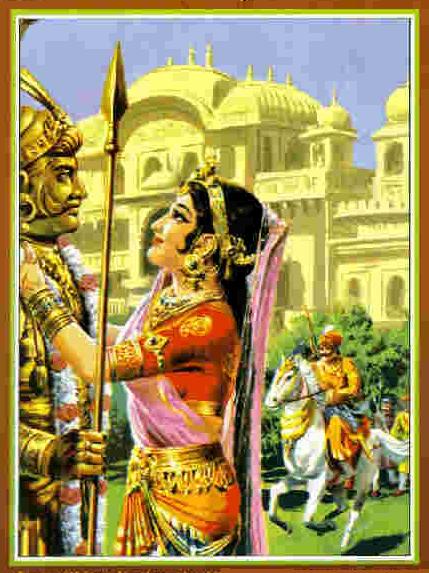
The Legendary Prithviraj
Chauhan III was the last
of the great Chauhan rulers of Ajmer, Rajasthan.
To this day, Prithviraj Chauhan is
remembered by the Rajputs as a model of chivalry and courage, and is the hero of
many folk ballads.
The
Rajput warriors earned their reputation by fighting these battles with a code of chivalrous
conduct rooted in their strong adherence to tradition and (Hindu dharma).
***
Shivaji - The
Great Maratha Warrior
For about three hundred and
fifty years before Shivaji, Maharashtra was not a free state. A large portion of
it was under the rule of the Nizamshah of Ahmednagar and the Adilshah of Bijapur.
These two had divided Maharashtra among themselves. Their officers rules
Maharashtra on their behalf. Adilshah and Nizamshah, were very narrow in their
outlook and oppressed the people over whom they ruled. They were also sworn
enemies of each other. They constantly fought each other and as a result the
people of Maharashtra suffered untold hardships.
There was hunger everywhere and the people were starving. People were not free
to celebrate festivals and worship their Gods openly. Life was not safe at all
and injustice prevailed everywhere.
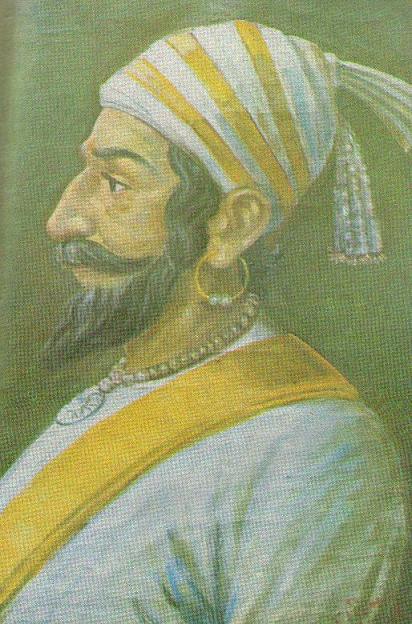
Shivaji - The
Great Maratha Warrior
***
On
this background, 18 year old Shivaji and his faithfuls took the oath at
Rohedeshwar Temple to establish a nation of the natives which Shivaji maintained
was the will of the providence. In his next 35 years he lived an epic which
thrilled the imagination of his friends and foes alike.
It
is true that Shivaji contributed a lot towards the rise
and growth of Maratha power in India, but it is equally true that at
the time he appeared on the scene, the ground had already been prepared for him.
Shivaji
Maharaj was coronated at
fort
Raigad
about 350 years ago. The throne was made up of gold and studded with diamonds.
Rabindranath
Tagore wrote about Shivaji’s great ideals:
“Into
one virtuous rule,
This divided, broken, distracted
India
I shall bind.”
In his
essay on Shivaji and the Maharastrains written in Bengali from the Visva Bharati
quarterly, he wrote:
In the
history of Maharastrians we find Shivaji in the dominating role. But Shivaji
could never have achieved greatness, had not the whole of the Maharastrian
nation made him great. The religious movement in
Maharashtra
was uniting the people through a process of churning. Shivaji’s genius was
derived from that churning."
Sir
Jadunath Sarkar was right in observing that, “Shivaji’s ideals
were such that we might accept them even today without any change.”
“He
was a person of middling height, with an erect bearing and excellent
proportions, very active and whenever he used to speak, it appeared as if he was
smiling. He had quick and piercing eyes and was fairer than any of his own
people.” -
English
Records on Shivaji – vol. 1 p. 73. January 1664.
“With
a success as happy as Ceasar’s in Spain; he came, saw, and overcame and is
reported to have taken so vast a treasure in gold, diamonds, emeralds, rubies
and wrought corall that have strengthened his arms with very able sinews to
prosecute his further designs.
“He being no less dexterous, thereat (conquests) than Alexander the
Great was for, by the agility of his winged men (himself terming them birds) he
took in less than eight months what he had delivered to Jaysing.”
-
English
Records on Shivaji – vol. II p. 150. dated January 1677- 78.
“But
it is too well known that Shivaji is as second Sertorious, and comes not short
of
Hannibal
for Stratagems.”
-
English
Records on Shivaji. Vol II p. 153. dated February 14 1677 – 78.

“Into
one virtuous rule,
This divided, broken, distracted
India
I shall bind.”
***
Sir
Jadunath Sarkar, House of Shivaji
p. 115 remarked:
“The
Historian of Shivaji at the end of a careful study of all the records about him
in eight different languages, is bound to admit that Shivaji was not only the
maker of the Maratha nation, but also the greatest constructive genius of
medieval
India
. States fall, empires break up, dynasties become extinct, but the memory of a
true “hero as King” like Shivaji remains an imperishable historical legacy
for the entire human race. – The pillar of people’s hope. The center of a
world’s desire, to animate the heart, to kindle the imagination, and to
inspire the brain of succeeding ages to the highest endeavors.”
According
to Dr. Ishwari Prasad, "But
Shivaji's rise to power cannot be treated as an isolated phenomenon in Maratha
history. It was as much the result of his personal daring and heroism as of the
peculiar geographical situation of the Deccan country and unifying religious
influences that were animating the people with new hopes and aspirations in the
15th and 16th centuries."

The
Maratha the most formidable enemy; for he will not fail in boldness and
enterprise when they are indispensible, and will always support them or supply
their place, by stratagem, activity and perseverance.
***
Pandit
Jawaharlal Nehru
said:
"Shivaji did not belong to Maharashtra alone; he belonged to the whole
Indian nation."
"Shivaji
was not an ambitious ruler anxious to establish a kingdom for himself but a
patriot inspired by a vision and political ideas derived from the teachings of
the ancient philosophers. He studied the merits and faults of the systems of
administration in kingdoms existing at the time and determined his own policies
and administration in the light of that knowledge.
A devout Hindu, he was tolerant of other religions and
established a number of endowments for maintainig sacred places belonging to
them. As a general he was undoubtedly one of the greatest in Indian
history; he saw the need for and raised a navy to guard his coastline and to
fight against the British and the Dutch. Pratapgad Fort build in 1656 stands
today as a monument to his military genius. Shivaji
is a symbol of many virtues, more especially of love of country."
A.B. de Braganca Pereira Arquivo
Portugues Oriental, Vol III
wrote:
"Wonderous mystic, adventurous and intrepid, fortunate, roving prince, with
lovely and magnetic eyes, pleasing countenance, winsome and polite, magnanimous
to fallen foe like Alexander, keen and a sharp intellect, quick in decision,
ambitious conqueror like Julius Caesar, given to action, resolute and strict
disciplinarian, expert strategist, far-sighted and constructive statesman,
brilliant organizer, who sagaciously countered his political rivals and
antagonists like the Mughals, Turks of Bijapur, the Portuguese, the English, the
Dutch, and the French. Undaunted by the mighty Moghuls, then the greatest power
in Asia. He fought with Bijapuri to carve out a great empire."
D.
Kincaid - The
Grand Rebel
"In
spite of the character of a crusade which Ramdas's blessings gave to Shivaji's
long struggle, it is remarkable how little religious animosity or intolerance
Shivaji displayed. His kindness to Catholic priests is an agreeable contrast to
the proscriptions of the Hindu priesthood in the Indian and Maratha territories
of the Portuguese. Even his enemies remarked on his extreme respect for
Mussulman priests, for mosques and for the koran. The Muslim historian Khafi
Khan, who cannot mention Shivaji in his cronicle without adding epithets of
vulgar abuse, nevertheless acknowledges that Shivaji never entered a conquered
town without taking measures to safeguard the mosques from damage. Whenever a
koran came to his possession, he treated it with the same respect as if it had
been one of the sacred works of his own faith. Whenever his men captured
Mussulman ladies, they were brought to Shivaji, who looked after them as if they
were his wards till he could return them to their relations."
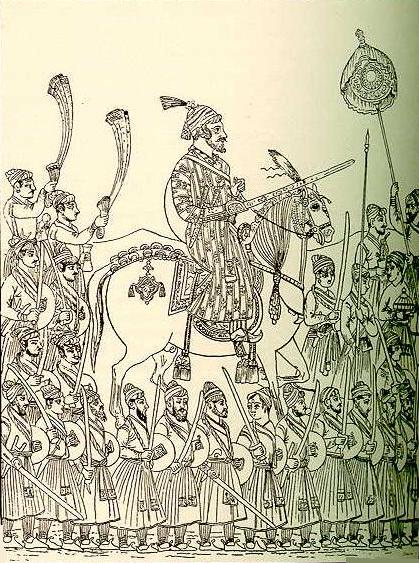
Shivaji: The
founder of the Maratha power.
(image source: India Armour - By Lord Egerton, Lord of
Tatton).
***
Cosme
da Guarda -
Life
of the Celebrated Sevaji:
"Such was the good treatment Shivaji accorded to people and such was the
honesty with which he observed the capitulations that none looked upon him
without a feeling of love and confidence. By his people he was exceedingly
loved. Both in matters of reward and punishment he was so impartial that while
he lived he made no exception for any person; no merit was left unrewarded, no
offence went unpunished; and this he did with so much care and attention that he
specially charged his governors to inform him in writing of the conduct of his
soldiers, mentioning in particular those who had distinguished themselves, and
he would at once order their promotion, either in rank or in pay, according to
their merit. He was naturally loved by all men of valor and good conduct."
Prime
Minister Indira Gandhi
observed:
"I
think Shivaji ranks among the greatest men of the world. Since we were a slave
country, our great men have been somewhat played down in world history. Had the
same person been born in a European country, he would have been praised to the
skies and known everywhere. It would have been said that he had illumined the
world."
Sir
E. Sullivan says in Warriors and Statesmen
of India
"Shivaji
possessed every quality requisite for success in the disturbed age in which he
lived. Cautious and wily in
council, he was fierce and daring in action; he possessed an endurance that made
him remarkable even amongst his hardy subjects, and an energy and decision that
would in any age have raised him to distinctions.
By his own people he was painted on a white horse going at full gallop,
tossing grains of rice into his mouth, to signify that his speed did not allow
him to stop to eat. He
was the Hindu prince who forced the heavy Mughal cavalry to fly before the
charge of the native horse of India. His
strength and activity in action were glory and admiration of his race."
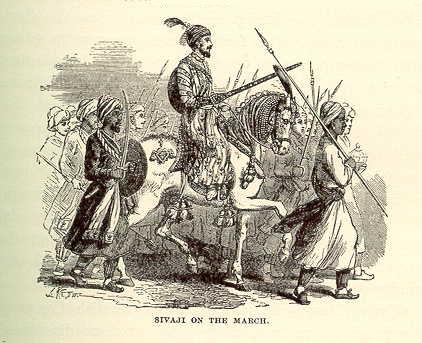
Shivaji on
the March.
(image
source: History of
India - By A V Williams Jackson).
***
Nobel
laureate Rabindranath Tagore
(1861-1941) poet, author, philosopher, Nobel prize
laureate. Tagore
was deeply critical of the British Raj in India. He wrote a poem:
In
what far-off country, upon what obscure day
know not now,Seated in the gloom of some Mahratta mountain-wood
O King Shivaji,
Lighting thy brow, like a lightning flash,
This thought descended,
"Into one virtuous rule, this divided broken distracted India,
I shall bind."
As Sir
Jadunath Sarkar (1870-1958) eminent historian, has well expressed:
"Shivaji proved, by
his example, that the Hindu race could build a
nation, found a State, defeat its enemies; they could conduct their
own defence; they could protect and promote literature and art, commerce and
industry; they could maintain navies and ocean going fleets of their own, and
conduct naval battles on equal terms with foreigners. He taught the modern
Hindus to rise to the full stature of their growth. He demonstrated that the tree
of Hinduism was not dead, and that it could put forth new leaves and
branches and once again rise up its head to the skies.
"
(source:
Shivaji
and His Times - By Sir Jadunath Sarkar p. 406).

Goddess Bhavani at Pratapgad
Fort.
***
D.
F. Karaka author of Shivaji:
Portrait of an Early Indian has written the following passage:
"
...by birth a Hindu, by caste a Maratha but by his own inclination Shivaji was
an early Indian who fought to preserve the native heritage of the people of the
land from the foreign invaders, at that time Moghul and Muslim, but to Shivaji's
way of thinking, it could
have been anyone else"
(source: Shivaji:
Portrait of an Early Indian - By Dosabhai
Framji Karaka p. 167).
Leaders such
as Lala Lajpat Rai, Tilak, Annie Besant, Aurobindo Ghosh and poet Tagore have
paid eloquent tributes to Shivaji as a great national leader and the builder of
the country.
(source:
Shivshahi.on
the Web).
Shivaji
and Aurangzeb - An All India Struggle
Shivaji
had broadend the struggle against the Mughals into an all India one. He had
brought the Deccan States together against the Mughals. He had enouraged the
Bundelas in their struggle. Ever tolerant of other faiths, Shivaji was hurt
beyond measure by Aurangzeb's intolerant policies, such as the imposition of
Jizia and senseless destruction of places of worship. In a spirited letter to
Aurangazeb, Shivaji reminded the latter that intolerance would lead to the
ultimate destruction of the Mughal Empire and that toleration alone should be
the basis of any rule in a country like India. This letter is one of the great
documents of Indian history.
Aurangzeb
and Shivaji - The two represented two different forces in history, one
intolerant and narrow minded, the other liberal, humanitarian and tolerant. The
one aggressive and expansionist, the other spirited and defensive. In this
struggle, Shivaji and the spirit of Shivaji, which stood out for freedom,
justice, tolerance and humanity were the ultimate victors.
Shivaji's
Maritime Power
Having
realized fairly early in his meteoric career the importance of navy to his
realm, Shivaji set about achieving his aim in a methodical, deliberate manner,
as was his wont. Shivaji’s navy made a small beginning with his conquest of
what is today the district of Thane. Around 1659 a handful of his vessels plied
in inland waterways and creeks around Bhiwandi, Panvel and Kalyan and created
quite a stir among the Portuguese. With his ever growing power along the west
coast hinterland, he quickly enlarged the size of his navy. Besides the defence
of his territories, he pressed it into profitable ventures along the
Malabar Coast
.
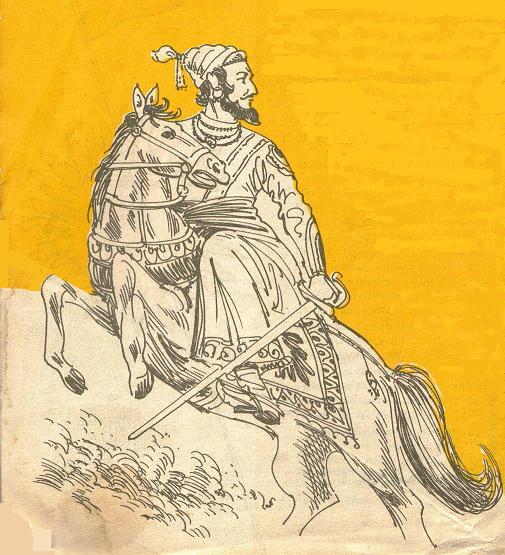
Shivaji on
horseback - It is a tribute to his foresight and military genius that side by
side with the development of his fleet, he carried out a systematic campaign of
capturing the forts along the coast and built fortifications at strategic
points.
***
It is a
tribute to his foresight and military genius that side by side with the
development of his fleet, he carried out a systematic campaign of capturing the
forts along the coast and built fortifications at strategic points. He spared no
efforts in collecting the very best among shipwrights and gunsmiths. Sindhudurg,
the Fort of the Ocean, built on an
island
of
Malvan
, on whose many bastions fluttered the Zari Patka, bore testimony to his immense
concern for safeguarding his maritime interests.
Shivaji’s
Fleet
His
fleet consisted of the big Gurabs, the slow moving gun boats, Galbats, sleek and
swift assault vessels, Shibars and Machwas, the trading vessels. At the peak of
its strength, Shivaji’s fleet had 700 vessels of various sizes, though most of
these belonged to the Mercantile Marine and were cargo carrying in nature. At
the time of his coronation in 1674, he had 57 major war ships and a total
strength of 5,000 able bodied men.


Mahartha Grab and Gallivat
ships attacking an English ship.
(image source: History of Indian Shipping - By Radha Kumud
Mukerjee).
For
more refer to chapters on Suvarnabhumi,
Pacific and Sacred
Angkor
***
Five
years later in 1679, the strength of big ships rose to 66. In 1665, barely five
years after the raising of his fleet from scratch, he mounted an expedition to
Karwar and Ankola with 85 assorted ships. This was essentially a ‘Show the
flag’ affair but also to build up the efficiency of his fleet. Again in 1670,
his fleet, much stronger now, set sail for another such ‘Show the flag’
expedition towards
Surat
. Such forays along the west coast created panic and concern among the alien
powers, notably the English and Portuguese. They presumably thought – “What
if he repeats his exploits at sea with similar tenacity and purpose as he has
carried out his lightning campaigns on land!
(source:
Shivaji: The Great Nation Builder - By S K Sagane
published by Government of Maharashtra, Mumbai, India).
The
Great Maratha Power
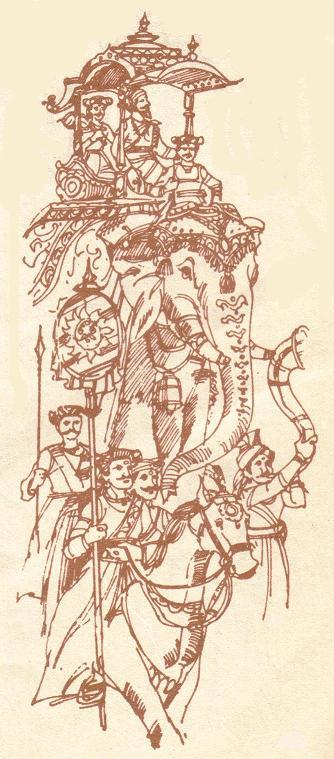 J.
Grant Duff says in History of the Marathas J.
Grant Duff says in History of the Marathas
"Bred
a soldier as well as a statesman, Bajeerao united the enterprise, vogour, and
hardihood of a Maratha chief with the polished manners, the sagacity, and
address which frequently distinguish the Brahmins of the Concan.
Fully acquainted with the financial schemes of his father, he selected
that part of the plan calculated to direct the predatory hordes of Maharashtra
in a common effort. In this
respect, the genious of Bajeerao enlarged the schemes which his father devised;
and unlike most Brahmins of him, it may be truly said- he had both- the head to
plan and the hand to execute."
Sir
R. Temple says in Oriental Experiences
"Bajirao
was hardly to be surpassed as a rider and was ever forward in action, eager to
expose himself under fire if the affair was arduous.
He was inured to fatigue and prided himself on enduring the same
hardships as his soldiers and sharing their scanty fare.
He was moved by an ardour for success in national undertakings by a
patriotic confidence in the Hindu cause as against its old enemies, the
Muhammadans and its new rivals, the Europeans then rising above the political
horizon. He lived to see the
Maratha spread over the Indian continent from the Arabian sea to the Bay of
Bengal. He died as he lived in camp
under canvas among his men and he is remembered among the Marathas as the
fighting Peshwa, as the incarnation of Hindu energy."
Jadunath
Sarkar says in his forward to Peshwa Bajirao
I and Maratha Expansion
"Bajirao was a heaven born cavalry leader.
In the long and distinguished galaxy of Peshwas, Bajirao Ballal was
unequalled for the daring and originality of his genius and the volume and value
of his achievements. He was truely
a carlylean Hero as king or rather as a Man of action.'
If Sir Robert Walpole created the unchallengeable position of the Prime
Minister in the unwritten constitution of England, Bajirao created the same
institution in the Maratha Raj at exactly the same time."
Surendra
Nath Sen says in The Military System of the
Marathas
"The
lover of Mastani knew well how to appeal to the religious sentiments of his
co-religionists, although he could scarcely be considered an orthodox Brahman...
Shivaji had given the Marathas a common cry, and none appreciated the potency of
that cry clearly than Peshwa Bajirao. Shivaji's
military reforms he would not or could not revive, but he stood forth, as Shivaji
had done, as champion of Hinduism.
People of Central and Northern India saw in him a new deliverer."
According
to J. N. Sarkar, nature developed in the
Marathas "Self-reliance,
courage, perseverance, a stern simplicity, a rough straight-forwardness, a sense
of social equality and consequently pride in the dignity of man as man. "
There were no social distinctions among the people and Maratha
women added to the strength and patriotism of men.
According
to Elphinstone
"They
(the Marathas) are all active, laborious, hardy and persevering. If they have
none of the pride and dignity of the Rajputs, they have none of their indolence
or want of worldly wisdom. A Rajput warrior as long as he does not dishonour his
race, seems almost indifferent to the result of any contest he is engaged in. A
Maratha thinks of nothing but the result, and cares little for the means, if he
can attain his object. For this purpose, he will strain his wits, renounce his
pleasures and hazard his person; but has not a conception of sacrificing his
life, or even his interest for a point of honour. This difference of sentiment
affects the outward appearance of the two nations; there is something noble in
the carriage of the ordinary Rajput, and something vulgar in that of the most
distinguished Maratha. The Rajput is the most worthy antagonist - the
Maratha the most formidable enemy; for he will not fail in boldness
and enterprise when they are indispensible, and will always support them or
supply their place, by stratagem, activity and perseverance. All this applies
chiefly to the soldiery to whom more bad qualities might fairly be ascribed. The
mere husbandmen are sober, frugal and industrious, and though they have a dash
of national cunning, are neither turbulent nor insincere."
Warren
Hastings had noted, "..The Marathas
possess alone of all the people of Hindostan and the Deccan a principle of
national attachment, which is strongly impressed on all the individuals of the
nation.."


The great
Maratha power - Bajirao Peshwa and Rani Lakshmi Bai.
***
Sir Hugh
Rose the commander of the British force, wrote later, "The Ranee
was remarkable for her bravery, cleverness and perseverance; her generosity to
her Subordinates was unbounded. These qualities, combined with her rank,
rendered her the most dangerous of all the rebel leaders." A popular Indian
ballad said:
How valiantly like a man
fought she,
The Rani of Jhansi
On every parapet a gun she set
Raining fire of hell,
How well like a man fought the Rani of Jhansi
How valiantly and well!
"Bundeli har boli mein suni yehi kahani
thi...
Khoob laDi mardaani woh toh Jhansi Wali Rani thi...."
(source:
Hindunet.org).
For more on Rani Lakshmi Bai refer to chapter on Women
in Hinduism and European
Imperialism). For
more refer to chapter on Greater
India: Suvarnabhumi and Sacred
Angkor
and Glimpses
VIII.
***
Page < 1 2 3 4 5 6 7 8 9 10 11 >
|